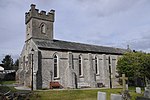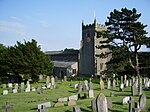Monastery of Our Lady of Hyning
Buildings and structures in the City of LancasterGrade II listed buildings in LancashireGrade II listed housesMonasteries in LancashireUse British English from August 2024

The Monastery of Our Lady of Hyning is a community of Bernardine Cistercians in Warton, Lancaster, England, formerly known as St Bernard's Priory and informally called Hyning Monastery. Its grade II listed house has also been known as The Hyning, Hyning Priory, Hyning Hall and Hyning House. It is in the north of the parish of Warton, east of the road to Yealand Conyers.
Excerpt from the Wikipedia article Monastery of Our Lady of Hyning (License: CC BY-SA 3.0, Authors, Images).Monastery of Our Lady of Hyning
Hyning Road, Lancaster Warton
Geographical coordinates (GPS) Address Website Nearby Places Show on map
Geographical coordinates (GPS)
| Latitude | Longitude |
|---|---|
| N 54.1535 ° | E -2.7552 ° |
Address
Monastery of Our Lady of Hyning
Hyning Road
LA5 9SF Lancaster, Warton
England, United Kingdom
Open on Google Maps










